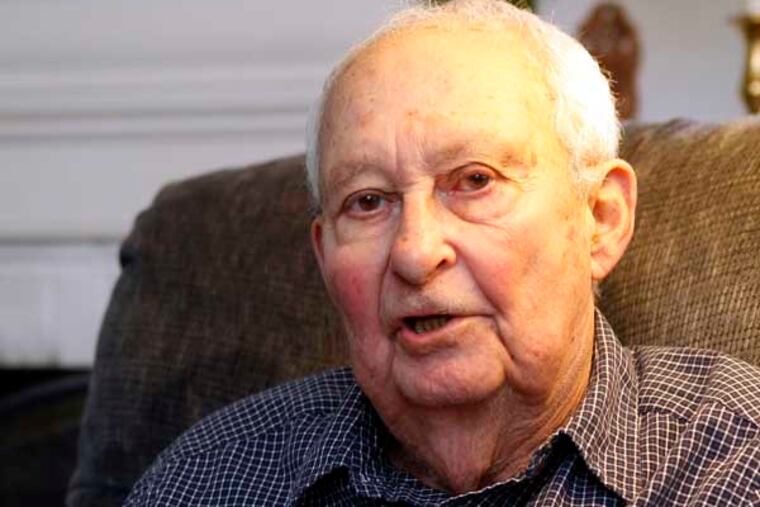70 years later, recalling an attack by German sub
Morton Raphelson was eating a biscuit in the dining room aboard the Pan Pennsylvania when he heard the blast and felt the great tanker shudder beneath him.

Morton Raphelson was eating a biscuit in the dining room aboard the Pan Pennsylvania when he heard the blast and felt the great tanker shudder beneath him.
"It was loud and clear," said the chief radio operator. "I knew exactly what happened."
The 516-foot-long, 11,000-ton ship had been struck by a German torpedo during World War II, and was sinking about 130 miles off Montauk, N.Y.
Seventy years later, Raphelson said he still remembers the breakfast he almost finished every time he has a biscuit. He also recalls lost comrades, a bold rescue, and a deadly sea battle.
But the 92-year-old Cinnaminson resident never imagined he'd come face to face with divers who not only visited the Pan Pennsylvania, but also the wreck of the nearly intact German submarine that attacked it before being sunk by a U.S. destroyer escort.
On Saturday, recalling Raphelson's interrupted meal, the divers plan to present him with a ship's plate, recovered on the ocean bottom near the gasoline tanker's stern.
"It's nice to know someone found my ship," said Raphelson, a former Merchant Marine and engineer who retired in 1985 from Radio Corp. of America in Camden. "I was kind of surprised" to learn the stern had been located.
The divers - three from New Jersey and three from Maryland, Massachusetts, and Connecticut - discovered the submarine U-550 and a nearby, then-unidentified, wreck in July 2012, using side-scan sonar equipment.
"I was really excited about the dive on the sub," said Joseph Mazraani, 36, a diver and North Brunswick, N.J., attorney. "When I landed on the deck, I had a reverential feeling.
"We were the first people to see it since 1944," he said.
Three hundred and thirty feet down, the ocean was dark but visibility was "outstanding," he said. Powerful lights illuminated the conning tower and hatches as the divers' cameras panned the scene. Damage from the destroyers' fire was still evident.
"You thought about the guys who sank the sub and the German sailors on it," Mazraani said. "It was amazing."
After U-550 fired a torpedo into the Pan Pennsylvania on April 16, 1944, it was hunted down by the Coast Guard and Navy destroyer escorts Joyce, Gandy, and Peterson.
Aboard the mortally wounded tanker, Raphelson left the mess deck, where plates were scattered by the shock of the explosion, and joined the captain and engineer in the wheelhouse. "I became convinced we ought to get off before we got hit with another torpedo," he said.
Twenty-five of the 81 officers, seamen, and armed guardsmen died in the attack. Some were lost when a lifeboat "tipped over," said Raphelson. "The ship was going 16 knots. . . . Everybody fell in the water."
The burning tanker eventually broke in two. Its stern dropped to the bottom while the rest floated 20 miles over the next two days before being sunk by American fire.
The sub, meanwhile, was heavily damaged by depth charges from the Joyce and forced to the surface, where it came under heavy fire from all three destroyers. U-550 was sinking in the frigid Atlantic waters as the crew surrendered and sought rescue.
More than 40 Germans were killed or drowned. Twelve survived, including the captain, who had a shrapnel wound to the head.
"It was extraordinary that the Joyce picked up survivors from the Pan Penn and the submarine, too," said Randall Peffer, 65, an author and tall ship captain who is writing a book about the wreck discoveries called Diving the Last U-boat. "The victims of both [vessels] were on the same ship together."
Aboard his diving boat, Tenacious, Mazraani and the other divers returned in 2013 to revisit the sub and check out the other site.
Much to their surprise and delight, the unknown wreck turned out to be the stern of the Pan Pennsylvania, resting in 340 feet of water. The larger section of the ship had been located in 1994 and was thought to be whole.
The stern "was a sight to see; it was amazing," said Mazraani. "We were in awe of the size of it.
"I had never seen a wreck so big," he said. "We used underwater scooters to lap it and poked our heads inside the engine room, where we saw some big machinery."
The stern rose 80 feet from the bottom and was 180 feet long.
The story of how it got there in 1944, "the tenacity of divers looking for a needle in a haystack," and the interest of the survivors and their families 70 years later is "extraordinary," Peffer said. "A lot of people feel new pride in their fathers and grandfathers."
One of the divers, Tom Packer of Berlin, was swimming over the wreck when he "recovered two plates laying in the open," Mazraani said. "Both said 'Warwick' and 'Made in the U.S.A.' and each was marked '1942' or '1943.' "
One of the plates will be given to Raphelson as "a memento of appreciation for his service during the war," Mazraani said. "He deserves it."